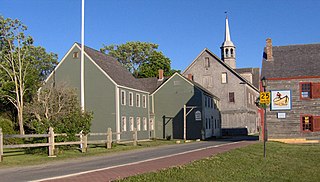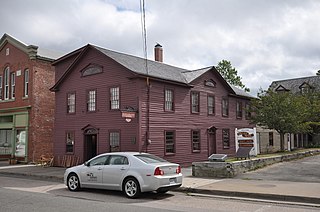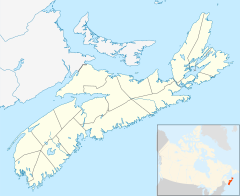
Nova Scotia is one of the thirteen provinces and territories of Canada. It is one of the three Maritime provinces and one of the four Atlantic provinces. Nova Scotia is Latin for "New Scotland".

Weymouth is a rural village located in Digby County, Nova Scotia on the Sissiboo River near its terminus on Baie Ste. Marie.

Shelburne is a town located in southwestern Nova Scotia, Canada.

Annapolis Royal, formerly known as Port Royal, is a town located in the western part of Annapolis County, Nova Scotia, Canada.

The 84th Regiment of Foot (Royal Highland Emigrants) was a British regiment in the American Revolutionary War that was raised to defend present day Ontario, Quebec and Atlantic Canada from the constant land and sea attacks by American Revolutionaries. The 84th Regiment was also involved in offensive action in the Thirteen Colonies; including North Carolina, South Carolina, Georgia, Virginia and what is now Maine, as well as raids upon Lake Champlain and the Mohawk Valley. The regiment consisted of 2,000 men in twenty companies. The 84th Regiment was raised from Scottish soldiers who had served in the Seven Years' War and stayed in North America. As a result, the 84th Regiment had one of the oldest and most experienced officer corps of any regiment in North America. The Scottish Highland regiments were a key element of the British Army in the American Revolution. The 84th Regiment was clothed, armed and accoutred the same as the Black Watch, with Lieutenant Colonel Allan Maclean commanding the first battalion and Major General John Small of Strathardle commanding the second. The two Battalions operated independently of each other and saw little action together.

St. Paul's Church is an evangelical Anglican church in downtown Halifax, Nova Scotia, within the Diocese of Nova Scotia and Prince Edward Island of the Anglican Church of Canada. It is located at the south end of the Grand Parade, an open square in downtown Halifax with Halifax City Hall at the northern end.

The Old Burying Ground is a historic cemetery in Halifax, Nova Scotia, Canada. It is located at the intersection of Barrington Street and Spring Garden Road in Downtown Halifax.

The history of Nova Scotia covers a period from thousands of years ago to the present day. Prior to European colonization, the lands encompassing present-day Nova Scotia were inhabited by the Mi'kmaq people. During the first 150 years of European settlement, the region was claimed by France and a colony formed, primarily made up of Catholic Acadians and Mi'kmaq. This time period involved six wars in which the Mi'kmaq along with the French and some Acadians resisted the British invasion of the region: the French and First Nation Wars, Father Rale's War and Father Le Loutre's War. During Father Le Loutre's War, the capital was moved from Annapolis Royal, Nova Scotia, to the newly established Halifax, Nova Scotia (1749). The warfare ended with the Burying the Hatchet ceremony (1761). After the colonial wars, New England Planters and Foreign Protestants immigrated to Nova Scotia. After the American Revolution, Loyalists immigrated to the colony. During the nineteenth century, Nova Scotia became self-governing in 1848 and joined the Canadian Confederation in 1867.

Black Nova Scotians are Black Canadians whose ancestors primarily date back to the Colonial United States as slaves or freemen, later arriving in Nova Scotia, Canada, during the 18th and early 19th centuries. As of the 2021 Census of Canada, 28,220 Black people live in Nova Scotia, most in Halifax. Since the 1950s, numerous Black Nova Scotians have migrated to Toronto for its larger range of opportunities. Before the immigration reforms of 1967, Black Nova Scotians formed 37% of the total Black Canadian population.

Rose Fortune was a child born in or around Philadelphia of runaway slaves. Her parents became Black Loyalists during the American Revolutionary War when they pledged to be loyal to the British Army in exchange for their freedom. At around the age of 10, Rose was among the approximately 3,000 Black Loyalists who sailed from New York City to Nova Scotia in 1783. She had at least three children and is thought to have been married twice. At about 50 years of age she began a business transporting luggage in a wheelbarrow from the Annapolis ferry docks to hotels and houses. By the early 1840s, she was using horse-drawn carriages to convey the luggage. She became the first female police officer in North America when she instituted and enforced curfews to keep the streets safe at night. Fortune is remembered for her business sense, strength, and courage.
Mount Hanley is a Canadian rural community in Annapolis County, Nova Scotia. It is the birthplace of the mariner Joshua Slocum and of Clara Belle Marshall, the first woman to graduate from Acadia University in 1879.

Birchtown is a community and National Historic Site in the Canadian province of Nova Scotia, located near Shelburne in the Municipal District of Shelburne County. Founded in 1783, the village was the largest settlement of Black Loyalists and the largest free settlement of ethnic Africans in North America in the eighteenth century. The two other significant Black Loyalist communities established in Nova Scotia were Brindley town and Tracadie. Birchtown was named after British Brigadier General Samuel Birch, an official who helped lead the evacuation of Black Loyalists from New York.

The Yarmouth County Museum & Archives is a museum located in Yarmouth, Nova Scotia, Canada. This museum explores the history of Yarmouth County. Located in the heart of Yarmouth's heritage residential district, the museum is housed in a former church as well as two historic houses. It also operates a summer display in the restored Killam Brothers Shipping Office on the Yarmouth waterfront.

The Bailey House in Annapolis Royal, Nova Scotia, Canada is a historic house built around 1770, making it the one of the oldest wood frame houses in Canada. It has been operating as a lodging, with interruptions, since at least 1837. The building is a Georgian style and is largely unaltered since its original construction. The house is part of the Annapolis Royal Historic District.
The de Gannes-Cosby House in the Annapolis Royal Historic District is the oldest wood framed building in Canada. It is also the world's oldest existing building in the Acadian style. It was built in 1708 by Major Louis-Joseph de Gannes de Falaise, a French nobleman and officer stationed at the French colony of Port Royal in what is today the province of Nova Scotia. The house is built on the foundations of an earlier house destroyed during the 1707 Siege of Port Royal. The core house was a simple wattle and daub construction, but has since been covered in wooden shingles and enlarged in the 19th and 20th centuries. It has been designated as a National Historic Site and is part of the Annapolis Royal Historic District.

The Sinclair Inn is a museum, former inn and second oldest wood framed building in Canada. It is located in Annapolis Royal, Nova Scotia, Canada. The building is the result of the merger of two pre-existing buildings during the 18th century. It also served as the location of the first Masonic lodge in Canada in 1738. Between 1780 and 1950 it operated as an inn and was later converted into a museum. The building is designated as a National Historic Site of Canada.

The Adams-Ritchie House is one of the oldest wood framed buildings in Canada. It is located in Annapolis Royal, Nova Scotia, Canada and dates from 1713. Over the past 300 years, the building was expanded and embellished until the original building was completely hidden. In the 1980s, it was restored to its original appearance. Prior to 1749, the house occasionally hosted the Nova Scotia Council, the fore-runner of the Nova Scotia House of Assembly.
The O'Dell House Museum is a house-museum located in Annapolis Royal, Nova Scotia, Canada which presents a collection of artefacts important to the history of Annapolis Royal. The museum also houses the Annapolis Heritage Society's Genealogy Centre and its Archive and Collections Centre. The original building was constructed in 1869 by Nova Scotia Pony Express rider, Corey O’Dell. A Victorian house in Greek revival style, it is part of the Historic District of Annapolis Royal.

The Bonnett House in Annapolis Royal, Nova Scotia, Canada is a historic house built around 1773, making it the one of the oldest wood-frame houses in Canada. The building is a Georgian style and is largely unaltered since its original construction. The house is part of the Annapolis Royal Historic District.



















